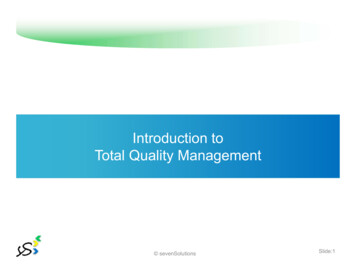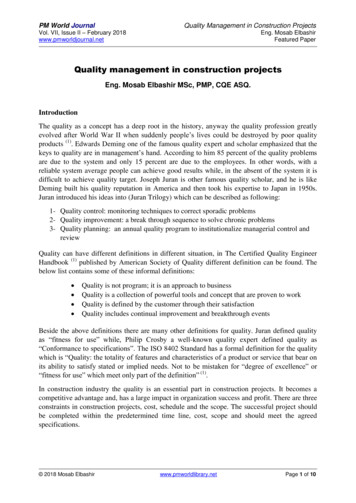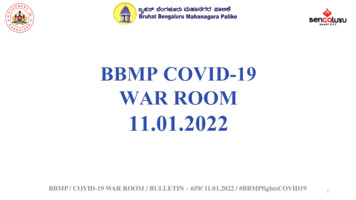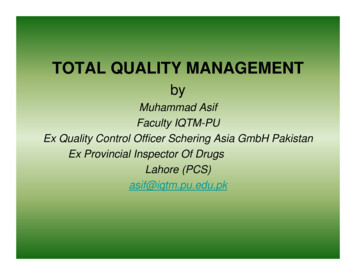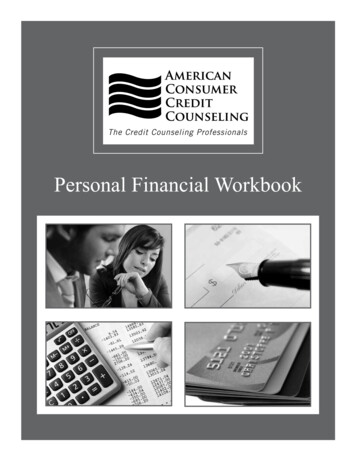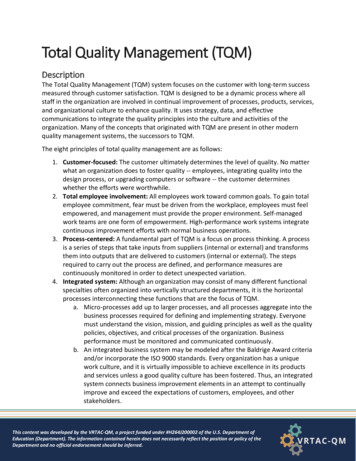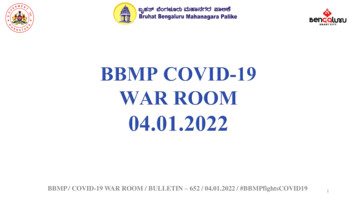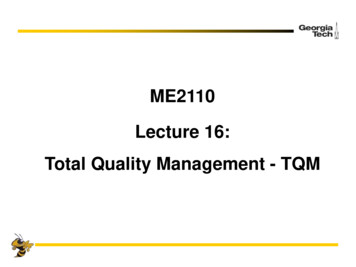
Transcription
GE 2022TOTAL QUALITY MANAGEMENT(Common to all branches)UNIT I : INTRODUCTION3 0 0 1009Introduction - Need for quality - Evolution of quality - Definition of quality - Dimensions ofmanufacturing and service quality - Basic concepts of TQM - Definition of TQM – TQM Framework Contributions of Deming, Juran and Crosby – Barriers to TQM.UNIT II : TQM PRINCIPLES9Leadership – Strategic quality planning, Quality statements - Customer focus – Customer orientation,Customer satisfaction, Customer complaints, Customer retention - Employee involvement – Motivation,Empowerment, Team and Teamwork, Recognition and Reward, Performance appraisal - Continuousprocess improvement – PDSA cycle, 5s, Kaizen - Supplier partnership – Partnering, Supplier selection,Supplier Rating.UNIT III : TQM TOOLS & TECHNIQUES I9The seven traditional tools of quality – New management tools – Six-sigma: Concepts, methodology,applications to manufacturing, service sector including IT – Bench marking – Reason to bench mark,Bench marking process – FMEA – Stages, Types.UNIT IV : TQM TOOLS & TECHNIQUES II9Quality circles – Quality Function Deployment (QFD) – Taguchi quality loss function – TPM – Concepts,improvement needs – Cost of Quality – Performance measures.UNIT V : QUALITY SYSTEMS9Need for ISO 9000- ISO 9000-2000 Quality System – Elements, Documentation, Quality auditing- QS9000 – ISO 14000 – Concepts, Requirements and Benefits – Case studies of TQM implementation inmanufacturing and service sectors including IT.TOTAL : 45TEXT BOOKDale H.Besterfiled, et al., “Total Quality Management”, Pearson Education, Inc. 2003. (Indian reprint2004). ISBN 81-297-0260-6.REFERENCESJames R.Evans & William M.Lidsay, “The Management and Control of Quality”, (5th Edition), SouthWestern (Thomson Learning), 2002 (ISBN 0-324-06680-5).Feigenbaum.A.V. “Total Quality Management”, McGraw Hill, 1991.Oakland.J.S. “Total Quality Management”, Butterworth – Hcinemann Ltd., Oxford. 1989.Narayana V. and Sreenivasan, N.S. “Quality Management – Concepts and Tasks”, New Age International1996.Zeiri. “Total Quality Management for Engineers”, Wood Head Publishers, 1991.Page 1 of 23
Total Quality ManagementUNIT-1INTRODUCTIONIntroduction - Need for quality - Evolution of quality - Definition of quality - Dimensions ofmanufacturing and service quality - Basic concepts of TQM - Definition of TQM – TQM Framework Contributions of Deming, Juran and Crosby – Barriers to TQM.INTRODUCTIONLiberalization and Globalization: With the opening up of the economy multinational companies, theworld over, are setting up organizations in India. Also, Indian Government has liberalized and manyproducts that were previously manufactured by the public sector and government organizations are nowbeing manufactured by Private organizations.The opening up of the economy has brought to the advantage of the customers many benefits Sellers market to Buyers market: Previously, Customers had to depend on only a few products.They are now able to choose whatever the product they want. So organizations have to be agileand introduce many variants of the same product and that too in a very short period of time.Awareness: With the connectivity increasing, the world has become very small and even remoteplaces are now connected through internet and mobile phones, not to mention the connectivitythrough road and rail.Increased Competition: More and more organizations are setting up industries in India toproduce products and services. Also, any product produced anywhere in the world can be sold inany part of the world.Indian companies have come under lot of pressure under the present circumstances because Freedom to produce: Many products that were under the domain of the cottage industry are nowbeing manufactured by multinational companies (ex: chips, soft drinks).Organizational Systems and Culture: These multinational companies that enter the Indianmarket bring with them proven systems through which they have a great advantage over many ofthe Indian organizations that still need to think in terms of progressive systems.In view of the above circumstances organizations in India need to look ahead to be competitive to surviveand succeed. One of the best ways of taking the first step forward is to Improve productivity of all activities, inside the organization and in the delivery process i.e.,they need to respond faster to the environmental requirement and produce products and servicesat continually reduced costs. Secondly, organizations need to process information and products at a faster rate, For this tohappen managers in such organizations need to be provided with updated, timely and strategicinformation All the departments in the organization need to work in unison to serve the ultimate customer.Customer is the king in the present age and he will not pay for the producers’ inefficiency. Product costs have to continually decrease.All these things should happen in a situation in which employee salary, interests on loans, insurance costselectricity charges, to name a few, keep on increasing as expenses to the organization.Page 2 of 23
QUALITYQuality has been the most exploited word but at the same time most mis-understood word. Quality is anoff shoot of the work we do. It is a bi-product of an act. It shows the level of commitment in doing ouractivity.Examples such as: High quality at low price, Quality Hawaii chappal, High class quality etc., are beingmentioned.Definition: The Quality is defined in many ways:Quality is Excellence: When quality is defined as excellence, it loses its measurability. Each personunderstands to the level of his own excellence and involves in his work. It is often misunderstood thathigh cost is high quality. Judgmental in nature. Ex. (Rolex watches, BMW automobiles).Quality is Value: With this definition the performance and features or the usefulness of the products arecompared to only the cost of price of the product. Many a times the utility/ possession value is more thanthe value of the product. Ex: the features of the product are compared to the cost of the product.Quality is Conformance to Requirements: This definition has a manufacturing orientation. It requiresthat the customer gives the specification and the products are manufactured to that requirement.Quality is degree to which the inherent capabilities of the product satisfy(implicit and explicit) Requirements (Customer driven).Need for Quality Good quality of goods and services can provide an organization with competitive edge. Good quality reduces costs due to product returns, rework and scrap. Good quality increases productivity, profits and other measures of success such as brand image,product image and company goodwill. Most importantly, good quality generates satisfied customers today and tomorrow. Good quality creates an atmosphere for high employee morale, which improves productivity.Page 3 of 23
Evolution of QualityBefore the conceptsand ideas of TQMwereformalised,much work hadtaken place over thecenturies to reachthis stage. Thissection charts theevolution,frominspection throughto the present dayconcepts of totalquality.From inspection to total qualityInspectionInspection involves measuring, examining, and testing products, process and services against specifiedrequirements to determine conformity. In the late Middle Ages, special measures were taken to inspectthe work of apprentices and journeymen in order to guard the Guild against claims of makeshift or shoddywork.During the early years of manufacturing, inspection was used to decide whether a worker’s job or aproduct met the requirements; therefore, acceptable. It was not done in a systematic way, but worked wellwhen the volume of production was reasonably low. However, as organisations became larger, the needfor more effective operations became apparent.In 1911, Frederick W. Taylor helped to satisfy this need. He published ‘The Principles of ScientificManagement’ which provided a framework for the effective use of people in industrial organisations. Oneof Taylor’s concepts was clearly defined tasks performed under standard conditions. Inspection was oneof these tasks and was intended to ensure that no faulty product left the factory or workshop;focuses on the product and the detection of problems in the product;involves testing every item to ensure that it complies with product specifications;is carried out at the end of the production process; and relies on specially trained inspectors.Accompanying the creation of inspection functions, other problems arose:Page 4 of 23
More technical problems occurred, requiring specialised skills, often not possessed by productionworkersThe inspectors lacked trainingInspectors were ordered to accept defective goods, to increase outputSkilled workers were promoted into other roles, leaving less skilled workers to perform theoperational jobs, such as manufacturingThis movement led to the emergence of a separate inspection department. An important new idea thatemerged from this new department was defect prevention, which led to quality control.Quality Control and Statistical TheoryQuality Control was introduced to detect and fix problems along the production line to prevent theproduction of faulty products. Statistical theory played an important role in this area. In the 1920s, Dr W.Shewhart developed the application of statistical methods to the management of quality. He made the firstmodern control chart and demonstrated that variation in the production process leads to variation inproduct. Therefore, eliminating variation in the process leads to a good standard of end products.Statistical Quality Control: focuses on product and the detection and control of quality problems;involves testing samples and statistically infers compliance of all products;is carried out at stages through the production process; andrelies on trained production personnel and quality control professionals.Shewart’s work was later developed by Deming, Dodge and Roming. However, manufacturingcompanies did not fully utilise these techniques until the late 1940s.Quality in JapanIn the 1940s, Japanese products were perceived as cheap, shoddy imitations. Japanese industrial leadersrecognised this problem and aimed to produce innovative high quality products. They invited a fewquality gurus, such as Deming, Juran, and Feigenbaum to learn how to achieve this aim.In the 1950s, quality control and management developed quickly and became a main theme of Japanesemanagement. The idea of quality did not stop at the management level. Quality circles started in the early60s. A quality circle is a volunteer group of workers who meet and discuss issues to improve any aspectsof workplace, and make presentations to management with their ideas.A by-product of quality circles was employee motivation . Workers felt that they were involved andheard. Another by-product was the idea of improving not only quality of the products, but also everyaspect of organisational issues. This probably was the start of the idea, total quality.Total QualityPage 5 of 23
The term ‘total quality’ was used for the first time in a paper by Feigenbaum at the first internationalconference on quality control in Tokyo in 1969. The term referred to wider issues within an organisation.Ishikawa also discussed ‘total quality control’ in Japan, which is different from the western idea of totalquality. According to his explanation, it means ‘company-wide quality control’ that involves allemployees, from top management to the workers, in quality control.Total Quality ManagementIn the 1980s to the 1990s, a new phase of quality control and management began. This became known asTotal Quality Management (TQM). Having observed Japan’s success of employing quality issues,western companies started to introduce their own quality initiatives. TQM, developed as a catchall phrasefor the broad spectrum of quality-focused strategies, programmes and techniques during this period,became the centre of focus for the western quality movement.Historical Review (Evolution in short-chronological order ) In the middle ages the concept of quality in the individuals was instilled by long hours of on thejob training. The manufacturer would act as the inspector. The concept of business was in thebarter system. Even now we see such skilled craftsmen like carpenters, idol makers and others,who make their own product and inspect it.In the early 20th century, the work of F.W.Taylor, known as the father of scientificmanagement, led to a new philosophy of separating planning function from execution function.During this phase the total work was segmented into specific work tasks for focusing onincreased efficiency. The quality assurance of the items/products produced fell into the hands ofthe inspectors. During manufacturing, defects were present but were removed by inspectorsbefore passing it on to the next stage or to the customer. Eventually organizations formed separatequality departments to pass materials produced. This worked during that period because of lack ofskill and education of the workers. Later on it led to a lot of indifference to quality amongproduction workers thinking that quality personnel were responsible for quality goods produced.o During this period Henry Ford had identified lot of best practices of Total Quality andput it in a book called “My Life and Work”, which people in Ford came to know laterwhen they visited Japan to learn best practices.o During 1920s in the Bell Telephone Laboratories, a team led by Walter Shewart,developed the control chart, which became a popular means of identifying qualityproblems in production processes and ensuring consistency of output.o During the Second World War sampling tables (MIL STD) were developed forsampling inspection.During the early 40s and 50s the shortage of civilian goods made production a top priority.Quality was not a priority of top managers and remained the domain of the specialist managers.Edward Deming learned statistical quality control from Shewart and propagated the same toJapanese along with Joseph Juran.During late 1970s and 1980s US managers were making frequent trips to Japan to see themiracle in Japan on Quality issues.During late 1980s automotive industry in US began to emphasize SPC. Suppliers and theirsuppliers were required to use these techniques. Genechi Taguchi introduced his concepts ofparameter and tolerance design and brought a resurgence of design of experiments.Page 6 of 23
The 1990s ISO 9000 became the worldwide model for quality management system.Dimensions of QualityManufacturing Quality Dimensions Performance Features Conformance Reliability Durability Service Aesthetics Reputation ResponsePerformance: A product’s primary operating characteristics. Automobile- Braking Distance, Acceleration, Steering, Handling, etc. Mobile Phone: Clarity, Audibility, Ease of use, etc.Features: Additional provisions provided in the product Automobile: Stereo systems, Antilock Brakes, Air conditioning Mobile Phones: MP3, Email facility,Reliability: Probability of product surviving over a specified period of time under specified conditions. Automobile: Able to start on cold days, Good mileage Mobile Phones: Catches even feeble signals, Battery life is goodConformance: The degree to which physical and performance characteristics of a product match preestablished standards Automobile: No sounds while driving as all components fit well with each other. Mobile: Battery and additional cards fit well into the unit. Battery gets charged properlyDurability: The amount of use one gets from a product before it physically deteriorates or untilreplacement is preferable. Automobile: Corrosion resistance, Upholstery wears. Mobile: Battery life, Sturdiness of buttonsSeviceability: The speed, courtesy and competence of repair work. Automobile: Ease with which the cables can be replaced. Mobile: Service expensesAesthetics: How a product looks, feels, tastes, smells and sounds Automobile: Colour, ergonomic seats, panel design Mobile: Sleekness, weight, Colour combinationReputation: The name the supplier has made over time Automobile: Maruthi Suzuki service. Mobile: Nokia’s reliabilityResponse: Willingness to help customers and provide prompt service. Automobile: Replacement of defective parts – TATA Indica, Honda Mobile: Nokia battery replacementPage 7 of 23
Service QualityService can be defined as ‘any primary or complimentary activity that does not directly produce aphysical product – that is, the non-goods part of the transaction between buyer (customer) and seller(provider).The service sector grew rapidly in the second half of the twentieth century. A service might be as simpleas handling a complaint or as complex as getting a housing loan. The service sector began to recognisethe importance of quality several years after manufacturing had done so. This lag can be attributed to thefact that service industry had not confronted the same aggressive foreign competition that manufacturingfaced. Another factor is the high turnover rate in service industry jobs. Constantly changing personnelmakes establishment of a continual improvement process more difficult.Service Quality Characteristics: Intangibility: inability to assess the value gained from engaging in an activity using any tangibleevidencePerish-ability: capacity cannot be stored for sale in the future.Inseparability: renders it impossible to divorce the supply or production of the service from itsconsumption.Variability: Differences in service in terms of time and person.Dimensions of Service Quality:Five key dimensions of service quality contribute to customer perceptions: Reliability: The ability to provide what was promised, dependably and accurately. Ex: providingerror free invoices, making repairs correctly first time. Assurance: The knowledge and courtesy of employees, and their ability to convey trust andconfidence. Ex: ability to answer questions, having capability to do the necessary work, avoidingpossible fraud with the system of operations. Tangibles: The physical facilities of the equipment, and the appearance of personnel. Attractivefront office, well dressed employees, well designed forms etc. Empathy: The degree of caring and individual attention provided by the customers. Ex:willingness to schedule deliveries at the customer’s convenience, explaining technical jargon in alayman’s language. Responsiveness: The willingness to help customers and provide prompt service. Ex: actingquickly to resolve problems, promptly crediting returned materials.Improving Service QualityCustomer service is the set of activities an organization uses to win and retain customers’ satisfaction. Itcan be provided before, during, or after the sale of the product or exist on its own. Elements of customerservice are:Organization:To ensure the same level of quality of service for all customers, organization must record andcommunicate to its employees the directions for all tasks. A service quality handbook has to be prepared.Page 8 of 23
Communicating it to all employees would be through formal training, videos, personal coaching, ormeetings. The organization shall take into consideration the following1. Identify each market segment they are serving.2. Write down the requirements.3. Communicate the requirements4. Organise processes5. Organise physical spaces.Customer Care:The organization should revolve around the customer, because customers are the key to the business. Theissues under customer care are:1. Meet the customers’ expectations2. Get the customer’s point of view.3. Deliver what is promised4. Make the customer feel valued.5. Respond to all complaints6. Over-respond to the customer7. Provide a clean and comfortable customer reception area.Communication:The organization should be in communication with its customers matching with its level of servicequality. A customer will be dissatisfied if what is advertised and what is delivered are not the same.Under communication organizations need to1. Optimize the trade-off between time and personal attention.2. Minimize the number of contact points3. Provide pleasant, knowledgeable, and enthusiastic employees.4. Write documents in customer-friendly language.Front Line People:Customers are the most valuable assets and should not be left to employees who have not been trained tohandle people and complaints. To attend to customers and their requirements, organizations need to1. Hire people who like people2. Challenge them to develop better methods3. Give them the authority to solve the problems.4. Serve them as internal customers5. Be sure they are adequately trained.6. Recognise and reward performanceQuality PlanningBefore offering any product/service to the market, organizations need to plan upfront, about the level ofquality, the features and the services they are going to offer in the market. They need to decide thecustomer segment they are going to serve with the products which they are making.Page 9 of 23
The steps for quality planning are as follows: Identify who are the customers: If a company is making a car, it has to decide which segmentof the society it is going to serve. Appropriately requirements have to be met.Determine the customer needs: An in-depth survey and detailed analysis has to be done toknow the requirements of the customer. Customers may ask for an automobile but their actualneed to be collected to know whether they are giving value for aesthetics or reliability.Translate the needs into language: Once requirements are noted, then the data has to beanalyzed to know the pattern or trend. Accordingly, the features and performance of the producthave to be defined.Develop a product to meet the needs: Once requirements have been translated to needs andparameters, a prototype need to be produced.Optimize the product so as to meet the company’s as well as the customers’ needs: Matchingthe customers’ requirement with the organizations capability to produce, it could be decided whatfeatures need to be added to the product and how the same could be manufactured. This is done inan organized process by making use of advanced tools and techniques, such as Quality FunctionDeployment and Failure Mode Effect Analysis.Develop the Process to produce the product: At this stage the knowledge and record in theearlier step is transferred to technical requirements and the machinery and processes need toproduce are added to the organization.Optimize the Process: The process has to be fine tuned to optimize the working condition inorder to minimize wastage and delay.Prove the processes can a make the product under optimal conditions: Produce products inthe setup to ensure that the setting of the process results in cost effective products and improvesefficiency of operation.Total Quality ManagementTQM is composed of three paradigms: Total: Organization wideQuality: With its usual Definitions, with all its complexities (External Definition)Management: The system of managing with steps like Plan, Organize, Control, Lead, Staff, etc.Definition: As defined by the International Organization for Standardization (ISO):"TQM is a management approach for an organization, centered on quality, based on the participation ofall its members and aiming at long-term success through customer satisfaction, and benefits to allmembers of the organization and to society."Basic Concepts: TQM requires six basic concepts1. A committed and involved management: TQM is a continual long term activity that must beimbibed in the culture of the organization. Everything begins with the long-term-top-to-bottomPage 10 of 23
2.3.4.5.6.organization support. Management must participate in the quality program, establish a council todevelop clear vision, set goals and direct the programs.An unwavering focus on the customer: Customers are the very purpose of any organization.Key to an effective TQM is orienting all activities towards the need of the customer, bothinternally and externally.Effective involvement and achievement of the entire work force: Implementing TQM iseveryone’s responsibility. Employees are the future of any organization. All personnel must betrained in TQM, its tools. They must be empowered to perform processes in an optimal manner.Continuous improvement of the business and production processes: All employees mustcontinually strive to improve all business and production systems.Treating Suppliers as Partners: 40 to 60 % of the product cost is outsourced. So all supplierorganizations have to be treated as extension of one’s organisations.Establish Performance measures: Measure and prosper. Measures should be available to notedowntimes, nonconformities and satisfaction of customers, absenteeism etc.Principles of Total Quality Management: The eight principles are:1. Customer-Focused Organisation2. Leadership3. Involvement of People4. Process Approach5. System Approach to Management6. Continual Improvement7. Factual Approach to Decision Making and8. Mutually Beneficial Supplier Relationships.Principle 1 - Customer-Focused Organisation"Organisations depend on their customers and therefore should understand current and future needs of thecustomer, meet customer requirements and strive to exceed customer expectations".Steps in application of this principle are:1. Understand customer needs and expectations for products, delivery, price, dependability, etc.2. Ensure a balanced approach among customers and other stake holders (owners, people, suppliers,local communities and society at large) needs and expectations.3. Communicate these needs and expectations throughout the organisation.4. Measure customer satisfaction & act on results, and5. Manage customer relationships.Principle 2 - Leadership"Leaders establish unity of purpose and direction of the organisation. They should create andmaintain the internal environment in which people can become fully involved in achieving theorganisation's objectives."Steps in application of this principle are:1. Be proactive and lead by example.2. Understand and respond to changes in the external environment.3. Consider the needs of all stake holders including customers, owners, people, suppliers, localcommunities and society at large.4. Establish a clear vision of the organisation's future.Page 11 of 23
5. Establish shared values and ethical role models at all levels of the organisation.6. Build trust and eliminate fear.7. Provide people with the required resources and freedom to act with responsibility andaccountability.8. Inspire, encourage and recognise people's contributions.9. Promote open and honest communication.10. Educate, train and coach people.11. Set challenging goals and targets, and12. Implement a strategy to achieve these goals and targets.Principle 3 - Involvement of People"People at all levels are the essence of an organisation and their full involvement enables theirabilities to be used for the organisation's benefit".Steps in application of this principle are:1. Accept ownership and responsibility to solve problems.2. Actively seek opportunities to make improvements, and enhance competencies, knowledge andexperience.3. Freely share knowledge & experience in teams.4. Focus on the creation of value for customers.5. Be innovative in furthering the organisation’s objectives.6. Improve the way of representing the organisation to customers, local communities and society atlarge.7. Help people derive satisfaction from their work, and8. Make people enthusiastic and proud to be part of the organisation.Principle 4 - Process Approach"A desired result is achieved more efficiently when related resources and activities are managedas a process."Steps in application of this principle are:1.2.3.4.Define the process to achieve the desired result.Identify and measure the inputs and outputs of the process.Identify the interfaces of the process with the functions of the organisation.Evaluate possible risks, consequences and impacts of processes on customers, suppliers and otherstake holders of the process.5. Establish clear responsibility, authority, and accountability for managing the process.6. Identify internal and external customers, suppliers and other stake holders of the process, and7. When designing processes, consider process steps, activities, flows, control measures, trainingneeds, equipment, methods, information, materials and other resources to achieve the desiredresult.Principle 5 - System Approach to Management"Identifying, understanding and managing a system of interrelated processes for a given objectiveimprove the organisation's effectiveness and efficiency."Page 12 of 23
Steps in application of this principle are:1.2.3.4.5.Define the system by identifying or developing the processes that affect a given objective.Structure the system to achieve the objective in the most efficient way.Understand the interdependencies among the processes of the system.Continually improve the system through measurement and evaluation, andEstimate the resource requirements and establish resource constraints prior to action.Principle 6 - Continual Improvement"Continual improvement should be a permanent objective of the organisation."Steps in application of this principle are:1. Make continual improvement of products, processes and systems an objective for everyindividual in the organization.2. Apply the basic improvement concepts of incremental improvement and breakthroughimprovement.3. Use periodic assessments against established criteria of excellence to identify areas for potentialimprovement.4. Continually improve the efficiency and effectiveness of all processes.5. Promote prevention based activities.6. Provide every member of the organisation with appropriate education and training, on themethods and tools of continual improvement such as the Plan-Do-Check-Act cycle, problemsolving, pro
Total Quality Management (TQM). Having observed Japan ¶s success of employing quality issues, western companies started to introduce their own quality initiatives. TQM, developed as a cat chall phrase for the broad spectrum of quality-focused s
